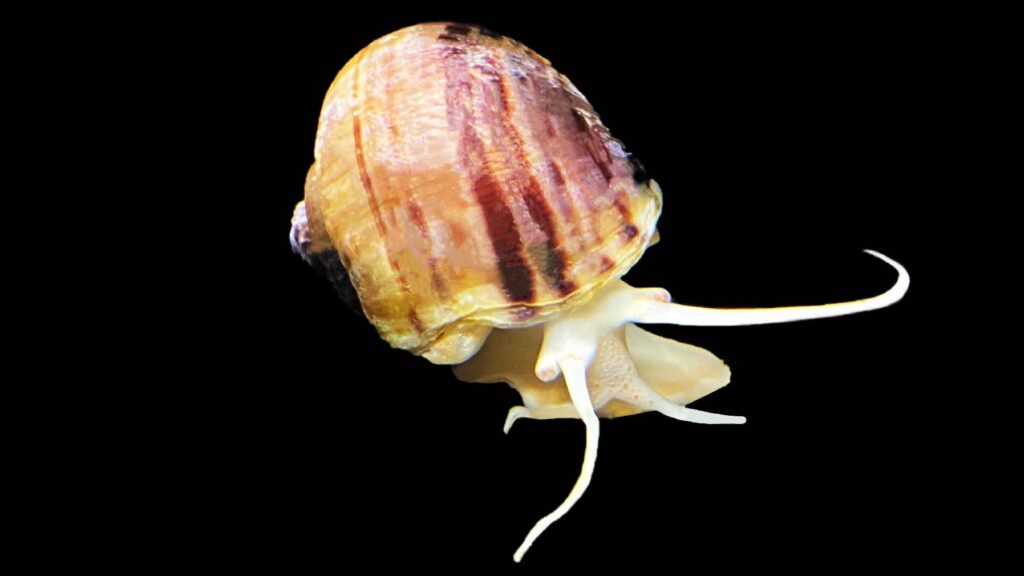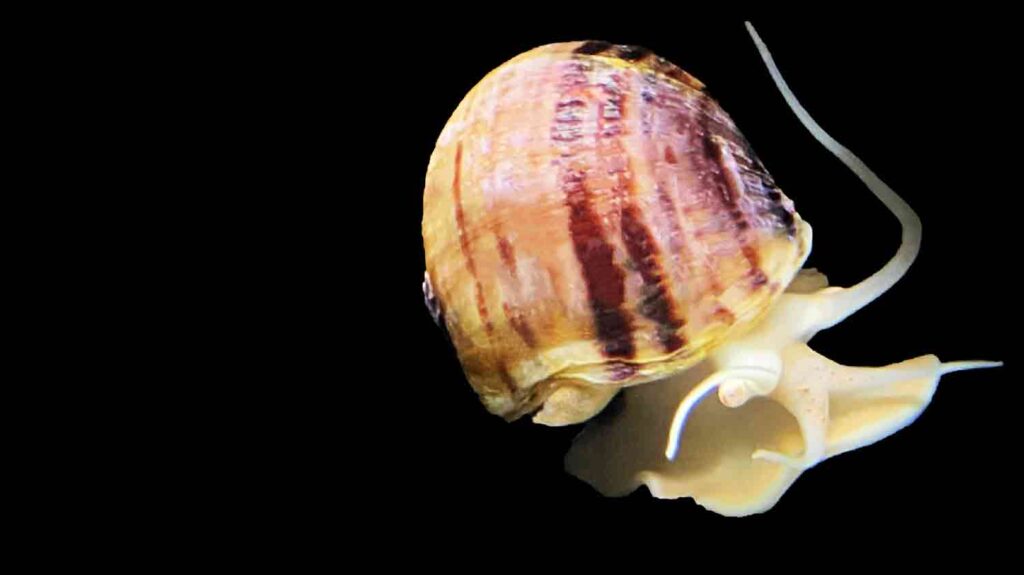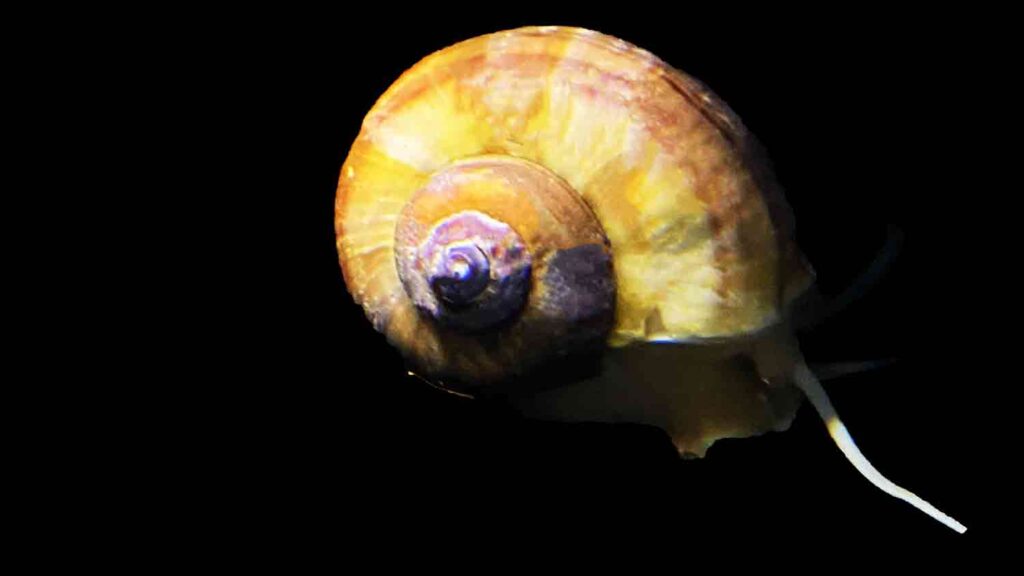The Apple Snail (Ampullariidae) is a freshwater snail often kept as a pet in the aquarium hobby. They gained their popularity for being the largest freshwater snail available as a pet for aquarium keepers. This colorful and large snail can be the focal point of your aquarium.
When it comes to keeping this snail, even if you’re not a big fan of snails, you’ll probably get amazed by their huge size and how friendly they are. They will constantly move in your aquarium and will keep eating the algae off your glass or other objects in the tank.
This guide will walk you through all the necessary information about Apple Snail to create an ideal environment for them in your tank.
Species Profile & Overview
Apple Snails can be found in different rivers, lakes, and bodies of water in Asia, parts of Africa as well as South America. Because of their similarity with mystery snails(Pomacea bridgesii), some might confuse the two. Both Apple Snails and Mystery Snails come in similar colors but the biggest difference between the two is their size. Apple Snails are almost 2 – 3 times bigger than Mystery Snails. Learn more about mystery snails in our Mystery Snail care guide.
After many years of being in the aquarium hobby, the Apple Snail now has line bred to have many different colors and patterns and they all are very big in size. That said, these colors and patterns will also occur naturally in the wild. They have a well-rounded body that can grow as big as a tennis ball.
Apple Snail lives in rivers and bodies of water that have lots of vegetation and plant matter. These plants and other decaying matter will make a huge part of their diet. The water in the regions they live in remains warm, clear, and well-oxygenated throughout the year. Recreating this type of setting in the aquarium will help your apple snail to thrive and live a long life.
Appearance

The Apple Snail is unlike any other snail in its magnificent beauty. Although they may come in brown, creamy white, or yellow colors, their gigantic size will make them look like absolute beauties that will wow any viewer. This makes it very easy to set them apart from other types of snails.
As mentioned earlier, they have round shells that grow to a very large size. This sets them apart from other snail species available in the hobby. The shell’s opening is very large compared to their body but they quickly block the opening with their shell door. The shell door (operculum) is made of the same materials as the shell but is not attached to the shell itself.
They have 4 tentacles near the eyes and mouth that will help them smell and scan their surroundings. The fifth tentacle-like organ is known as the lung-gill (siphon). They use this organ to breathe both in and out of water.
Some Apple snails come in single colors like dark brown, brown, creamy white, or yellow while others can develop striped patterns on their shells.
To maximize the vibrancy and avoid shell crackings of this snail, it’s important to match your tank’s parameters to what this snail has in the wild and give them all the nutrients they need.

Apple Snail Size
When fully grown, the Apple Snail will reach 2 -3 inches in diameter. This makes them one of the biggest aquarium snails in the world. With the right diet and tank maintenance, these beautiful creatures will quickly grow to their full size.
Lifespan
Apple Snail lifespan is about 1 – 3 years. Tank’s temperature has a direct effect on their lifespan. They will reach the 3-year mark only if the water temperature is kept on the cooler side and receive proper care.
Stable water conditions, regular water changes, and a proper diet in a cooler aquarium will help them to easily reach their expected life. More in the “Water Parameters” section of this article
Behavior & Temperament
Apple Snails are incredibly peaceful and will not cause any issues to other snails or fish. This makes them a superb addition to any peaceful community tank. They mainly stay at the bottom of the tank or on the aquarium glass to eat off the algae but will also go to the surface of the water to breathe or lay eggs. They are primarily active during the day but will also move around and up the surface for breathing at night.
They are slow-moving creatures that are fun to watch especially when they are busy cleaning the aquarium glass. Their beautiful coloration and their level of activity will keep you entertained for hours.
The Apple Snail is a slow-moving animal that will constantly forge for food. There are mixed reports about apple snails eating live aquarium plants. While they are fully capable of eating plants, live plants are not their first choice of food. In our experience, they will only eat dead leaves and might only eat your live plants if you neglect to feed them.
Their plant-eating behavior can be easily avoided by providing them with enough food to eat daily. Having fast-growing plants or hard-leave plants like anubias is another way to prevent them from going after your plants.
Apple Snail Care
Apple Snail care is super easy and simple. With a few adjustments, these giant snails can live in any size aquarium. These adjustments might not be necessary for you if you already have your tank with parameters that match what this snail needs.
The best approach to properly caring for these snails is to recreate the same parameters they have in their natural habitat. By doing this, you are letting your pet snail feel at home.
Tank Size
The minimum tank size for Apple Snails is 10 gallons. This is because they grow big and can reproduce rapidly. If you have a single apple snail and you are not planning to breed them you can also keep them in small tanks but we do not recommend doing this.
That said, if you are planning to have more than one Apple Snail, or you want to breed them, then you should definitely invest in a bigger aquarium. This snail breeds rapidly and in high numbers so it is important to have them in a large tank that can accommodate their future hatchlings.

Tank Setup
When setting up your snail tank it is important to focus on recreating their natural habitat. In order to recreate the natural habitat of the Apple Snail in your aquarium, you will need to have multiple rocks and driftwoods as well as lots of live plants. You will want to have them in a tank that is well-oxygenated and water quality is high.
When placing your decorations, make sure you give them enough space around and under decorations, for them to explore. This gives them a sense of security and safety as well as enough space to move in and clean any uneaten leftover foods.
More decorations will also make more surface area in the tank which means you can keep even more snails if you wish to. Since snails do not swim in the water column the decorations and plants will give the snails more surfaces to explore and look for algae or other sources of food.
Despite the fact that these snails can eat plants, we recommend planting live plants in your aquarium. Live plants are necessary for any healthy tank to remove harmful substances. When keeping plants with snails, make sure to feed your tank on a regular basis so they don’t eat your plants. They will, however, eat the dead leaves which is a plus point as it will keep your tank clean.
Calcium For Apple Snail
When it comes to keeping snails, you’ll have to provide them with a sustainable source of calcium so they can continue to grow and maintain their shell structure. Apple Snails are soft-bodied creatures and the only defense mechanism they have is their hard shell. This shell is mainly made of calcium carbonate so a source of calcium is necessary for them to maintain their shell’s hardness.
Calcium carbonate makes about 95-98% of their shell and the remaining 2% is other trace elements like Fe, Mg, Mn, Al, Na, and K that cause the different colorations of the shell.
You can supplement your tank with calcium by placing empty egg shells, cuttlebone, or commercially made calcium supplements for aquariums.
Water Parameters
Apple Snail comes from warm tropical regions of the world that are rich in oxygen. These rivers are filled with driftwood and other decaying plant matter that apple snails use as food sources.
These snails can tolerate a wider range of water parameters in an aquarium environment. Below are the ideal water parameters you can keep your apple snails in:
- Temperature: 65 – 82 Degrees Fahrenheit
- PH: 6.0 – 8
- TDS: 60 – 200 PPM
To ensure that the parameters and overall conditions of your tank remain consistent, it’s critical to adhere to a regular water change schedule. Consistent tank parameters are crucial for snail health and appearance. Quick changes in water parameters will cause cracking on the apple snail’s shell.
Filtration System
Snails in general and Apple Snails in particular, appreciate clean and oxygen-reach water. To maintain a clean environment for your snails, you will need to use a strong filtration system. Ammonia spikes are very dangerous for snails that can cause fatal events in an aquarium.
If you are not keeping any floating plants, we recommend using a filter that can create surface agitation to help with oxygen exchange in your tank.
Common Diseases & Prevention
Apple snails do not have any known diseases but are susceptible to fungus and bacterial diseases that are caused by low water quality. Maintaining a clean aquarium will eliminate this and your snails can live happily.
They are also at risk of getting their shell softened and eventually the shell completely collapses and they will die. This problem is not a disease but is caused by low levels of calcium in your aquarium. So it is important to have a good source of calcium in your tank at all times. See the “Calcium For Apple Snail” section of this article for more information.
Copper is another element that can kill apple snails. When buying decorations or food for your snails, make sure there is no copper in it. Some medications also come with copper, make sure not to use these medications to treat other fish in the tank as it will kill your snails.

Diet & Feeding Requirements
Apple Snails are herbivores (plant-eaters) but mostly eat algae and decaying matter. This makes it super easy to feed them. They can eat almost any kind of plant-based sinking pallet as well as most fresh vegetables.
Ideally, algae wafers and shrimp wafers can make great food sources for their daily diet. These commercially prepared foods will make feeding easy for you and they will not make your water cloudy or dirty.
Fresh vegetables are easy and cheap options to feed your snails. They will happily eat cucumber, green beans, carrots, potatoes, and zucchini. The only negative side to fresh vegetables is that if you feed them too much or if you forget to remove them after some time they will decay and pollute the tank. If you want to feed your apple snail fresh vegetables make sure not to feed too much and you will be fine.
Breeding Apple Snail
Breeding Apple Snails is very easy and simple. To breed your snail all you need to do is to lower the tank’s water by 2 – 3 inches and leave the rest to your snail. Apple snails lay their eggs out of the water so you have to lower the water a few inches so they can lay their eggs.
Depending on the room’s temperature the eggs will hatch in about 2-3 weeks. After the eggs hatch, they will quickly move into the water where they can continue to grow.
Apple snails are hermaphrodite, meaning each individual snail has both male and female reproductive organs. They can change their sex based on the availability of another gender. This means to breed them, you do not need to have a male and a female.
Tank Mates
Selecting tank mates for your Apple Snail isn’t hard at all as they can live with any peaceful fish. These snails are very passive and will not cause harm to their tank mates. The only time that you might see destructive behaviors from them is if you have fragile and sensitive plants and you neglect to feed your snails. Some individual Apple snails might develop an appetite for your plants if they don’t have enough food available.
Here are some great tank mates for your Apple Snail:

Conclusion
Apple snails are commonly mistaken for other types of snails and sold under the wrong names in pet stores. Now you know all about Apple Snail care and can confidently look after your pet snail. These fun-to-watch and peaceful creatures will make a great addition to your community tank.